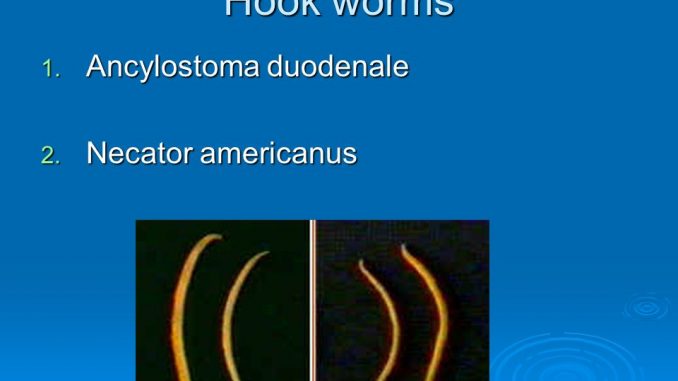
Ancyclostoma duodenale VS Necator americanus
| S.N | Characteristics of adult worm | Ancylostoma Duodenales | Necator americanus |
| 1 | Pathogenicity | More pathogenic | Less pathogenic |
| 2 | size | Larger and thick | Small and slender Male- 5-6 mm Female – 1 cm |
| 3 | Shape | Single curve looks like ‘C’ | Double curve looks like ‘S’ |
| 4 | Buccal capsule | Larger and oval. 6 teeth, 4 hook like teeth on ventral surface. 2 knob-like teeth on dorsal surface | Small and round. 4 chitinous plates- 2 on ventral surface and 2 on dorsal surface. |
| 5 | Anterior end | Bends in the same direction as body curvature | Bends in the opposite direction to the body curvature |
| 6 | Posterior end of female | A spine is present | No spine |
| 7 | Copulating bursa | Circle in shape. Dorsal ray is single, bifurcated at the tip, bifurcation is tripartite. Total number of rays is 13. | Oval in shape. Dorsal ray is split from base. Each bifurcation is bipartite. Total no of rays 14. |
| 8 | Copulatory spicule | Present | absent |
| 9 | Vulva position | Behind the middle of the body | In front the middle of the body |
| S.N. | Characteristics of filariform larvae | Ancylostoma duodenale | Necator americanus |
| 1 | Transverse cuticular striations | Less prominent | More prominent |
| 2 | Shape of head | Slightly conical | Rounded |
| 3 | Buccal cavity | -Shorter, 10-15 mm long -Lumen larger – chitinous wall thin Bounded by one line dorsally and two less prominent lines ventrally covered anteriorly -a fine line joins the oral depression and anterior end of buccal structure | Larger, 15-26 mm long -lumen shorter -chitinous wall thick -dorsal and ventral walls are of equal thickness, diverse anteriorly -no visible line between the oral depression and anterior end of buccal structure |
| 4 | Oesophago-intestinal junction | -no gap between the esophagus and intestine -anterior dilation of intestinal lumen less prominent | -An apparent gap between the esophagus and intestine -anterior dilation of intestinal lumen more prominent |
| 5 | Posterior end of intestine | A small refractile body is present | No refractile body |
| 6 | Position of genital rudiment | Behind the point midway between the end of esophagus and the anus. | In front of the point midway between the end of esophagus and anus. |
